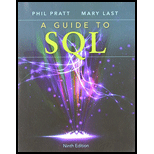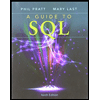
A Guide to SQL
9th Edition
ISBN: 9781111527273
Author: Philip J. Pratt
Publisher: Course Technology Ptr
expand_more
expand_more
format_list_bulleted
Question
Chapter 8, Problem 16RQ
Program Plan Intro
PL/SQL:
- In Oracle, the stored procedures can be created using a language called PL/SQL.
- The procedures are created and saved as the script files.
- SQL is used to perform the DML and DDL operations using the single query.
- Whereas the PL/SQL uses a block of codes to write the entire program in terms of blocks or procedures or functions.
Cursor:
Cursor is used to retrieve information in row by row fashion. If the records stored in the
Expert Solution & Answer
Want to see the full answer?
Check out a sample textbook solution
Students have asked these similar questions
Convert the relation Parking Tables to a set of 3NF relations.
Please original work
What is the importance of understanding both DSS models and OLAP in modern business analytics.
Reflect on how the combination of these tools can enhance decision-making processes in organizations.
Please cite in text references and add weblinks
Please original work
Talk about the role of Decision Support Systems (DSS) in business analytics.
What are the major types of models used in DSS: optimization, simulation, forecasting, heuristic, and descriptive models.
Talk about the relevance of these models in supporting business decisions.
Please cite in text references and add weblinks
Chapter 8 Solutions
A Guide to SQL
Ch. 8 - Prob. 1RQCh. 8 - Prob. 2RQCh. 8 - Prob. 3RQCh. 8 - Prob. 4RQCh. 8 - Prob. 5RQCh. 8 - Prob. 6RQCh. 8 - Prob. 7RQCh. 8 - Prob. 8RQCh. 8 - Prob. 9RQCh. 8 - In PL/SQL, how do you assign variables the same...
Ch. 8 - Prob. 11RQCh. 8 - Prob. 12RQCh. 8 - Prob. 13RQCh. 8 - Prob. 14RQCh. 8 - Prob. 15RQCh. 8 - Prob. 16RQCh. 8 - Prob. 17RQCh. 8 - Prob. 18RQCh. 8 - Prob. 19RQCh. 8 - Prob. 20RQCh. 8 - Prob. 21RQCh. 8 - Prob. 22RQCh. 8 - Prob. 1TDCh. 8 - Prob. 2TDCh. 8 - Prob. 3TDCh. 8 - Prob. 4TDCh. 8 - Prob. 5TDCh. 8 - Prob. 6TDCh. 8 - Prob. 7TDCh. 8 - Prob. 8TDCh. 8 - Prob. 9TDCh. 8 - Prob. 10TDCh. 8 - Prob. 1CATCh. 8 - Prob. 2CATCh. 8 - Prob. 3CATCh. 8 - Prob. 4CATCh. 8 - Prob. 5CATCh. 8 - Prob. 6CATCh. 8 - Prob. 7CATCh. 8 - Prob. 9CATCh. 8 - Prob. 1SCGCh. 8 - Prob. 2SCGCh. 8 - Prob. 3SCGCh. 8 - Prob. 4SCGCh. 8 - Prob. 5SCGCh. 8 - Prob. 6SCGCh. 8 - Prob. 7SCGCh. 8 - SQL includes many numerical functions. Two of...
Knowledge Booster
Similar questions
- Please original work What are two DSS models (e.g., optimization and forecasting). What are each model’s purpose, advantages, and limitations in the context of business analytics. Talk about some examples of how each model can be applied in real-world business scenarios, particularly in operations, marketing, or finance. Please cite in text references and add weblinksarrow_forwardPlease original work What is Online Analytical Processing (OLAP) and describe its role in DSS. Talk about how OLAP supports multidimensional analysis and decision-making in businesses. Compare how OLAP differs from traditional DSS models in terms of data processing and output. Please cite in text references and weblinksarrow_forwardPlease original work Describe the key steps involved in the modeling process: problem definition, data collection, model formulation, validation, implementation, and refinement. Talk about why each step is critical to ensuring the accuracy and reliability of the model. What are some real-world business example of a problem, and describe how the modeling process could be applied to address it using DSS. Please cite in text references and add weblinksarrow_forward
- You will be using the "usdata" package's "county" data # for this assignment. # You will need to run:# install.packages("usdata")# once to install this library - do not include the# install.packages command in your submission# as it can cause gradescope to fail ## ## ## ## ## DO NOT MODIFY BELOW ## ## ## ## ## library(usdata)county<-as.data.frame(county)county<-county[,1:14]county<-county[rowSums(is.na(county))==0,]# The set.seed command will ensure your results are consistent# each time you run the "source" commandset.seed(311)## ## ## ## ## DO NOT MODIFY ABOVE ## ## ## ## ## # Treating the "county" dataset as the population of US counties# create the dataframe "my.SRS" that represents a simple# random sample of n=250 individual counties from all counties in the US. my.SRS <- NA # Treating the "county" dataset as the population of US counties# create the dataframe "my.Stratified" that represents a stratified# sample of individual counties from all counties in…arrow_forwardPlease answer two JAVA OOP problems.arrow_forwardPlease answer this JAVA OOP problem.arrow_forward
- Answer two JAVA OOP problems.arrow_forward= 3. [40 pts] In the following C program ex2_2.c, we first declare and initialize an array int arr[3] {1,3,5}. Please convert the C code in main function into Assembly language. We provide the array initialization code in ex2_2_assembly.s for reference. Please complete and submit your code. ex2_2.c: #include int main() { } int arr[3] ={1,3,5}; //declare and initialize the array arr int x11 = arr[0]; int x12 = arr[1]; int x13 =x11x12; int x14 = x13 << x11; // "<<" is left shift operator arr[1] arr [2] = x13; = x14; return 0; //no need to convert this line into assembly languagearrow_forwardPlease answer JAVA OOP problem.arrow_forward
- Answer these two JAVA OOP questions.arrow_forwardPlease answer two JAVA OOP questions.arrow_forwardNow unmount the filesystem. Create a sparse image file, called book.img, of the 2GiB hard drive. Use a hexdump program to look at book.img and work out the offsets that store the contents of the book youdownloaded. Record the offsets as a sequence of one or more ranges of hexadecimal numbers. For example, in the following hexdump the text The rain in Spain falls mainly on the plain. is stored at 0x10-0x1f, 0x30-0x4b (inclusive). 00000000: 0000 0000 0000 0000 0000 0000 0000 0000 .................00000010: 5468 6520 7261 696e 2069 6e20 5370 6169 The rain in Spai00000020: 0000 0000 0000 0000 0000 0000 0000 0000.................00000030: 6e20 6661 6c6c 7320 6d61 696e 6c79 206f n falls mainly 000000040: 6e20 7468 6520 706c 6169 6e2e 0000 0000 n the plain........ Compress the filesystem using gzip by running: #gzip book.img This should leave you with a file book.img.gz. You will use scp to transfer this file in a later task. Enter your ranges in answers2.json as the answer for question1. To…arrow_forward
arrow_back_ios
SEE MORE QUESTIONS
arrow_forward_ios
Recommended textbooks for you

 A Guide to SQLComputer ScienceISBN:9781111527273Author:Philip J. PrattPublisher:Course Technology Ptr
A Guide to SQLComputer ScienceISBN:9781111527273Author:Philip J. PrattPublisher:Course Technology Ptr Database Systems: Design, Implementation, & Manag...Computer ScienceISBN:9781285196145Author:Steven, Steven Morris, Carlos Coronel, Carlos, Coronel, Carlos; Morris, Carlos Coronel and Steven Morris, Carlos Coronel; Steven Morris, Steven Morris; Carlos CoronelPublisher:Cengage Learning
Database Systems: Design, Implementation, & Manag...Computer ScienceISBN:9781285196145Author:Steven, Steven Morris, Carlos Coronel, Carlos, Coronel, Carlos; Morris, Carlos Coronel and Steven Morris, Carlos Coronel; Steven Morris, Steven Morris; Carlos CoronelPublisher:Cengage Learning Database Systems: Design, Implementation, & Manag...Computer ScienceISBN:9781305627482Author:Carlos Coronel, Steven MorrisPublisher:Cengage Learning
Database Systems: Design, Implementation, & Manag...Computer ScienceISBN:9781305627482Author:Carlos Coronel, Steven MorrisPublisher:Cengage Learning Programming with Microsoft Visual Basic 2017Computer ScienceISBN:9781337102124Author:Diane ZakPublisher:Cengage Learning
Programming with Microsoft Visual Basic 2017Computer ScienceISBN:9781337102124Author:Diane ZakPublisher:Cengage Learning


A Guide to SQL
Computer Science
ISBN:9781111527273
Author:Philip J. Pratt
Publisher:Course Technology Ptr

Database Systems: Design, Implementation, & Manag...
Computer Science
ISBN:9781285196145
Author:Steven, Steven Morris, Carlos Coronel, Carlos, Coronel, Carlos; Morris, Carlos Coronel and Steven Morris, Carlos Coronel; Steven Morris, Steven Morris; Carlos Coronel
Publisher:Cengage Learning

Database Systems: Design, Implementation, & Manag...
Computer Science
ISBN:9781305627482
Author:Carlos Coronel, Steven Morris
Publisher:Cengage Learning

Programming with Microsoft Visual Basic 2017
Computer Science
ISBN:9781337102124
Author:Diane Zak
Publisher:Cengage Learning